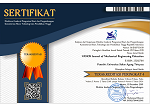Experimental Study of The Alternative Analysis of Cross-Section Variety of Half-Circle, Bowl and Isosceles Triangle to Generate Electricity: A Case Study of Pico Hydro-Pelton Turbines in ITATS Surabaya
Abstract
Keywords
Full Text:
PDFReferences
A. Susatyo, “Pembangkit listrik tenaga Pico hidro, cocok untuk daerah terpencil,” https://www.liputan6.com/regional/read/3947379/pembangkit-listrik-tenaga-Pico hidro-cocok-untuk-daerah-terpencil, 22-Apr-2019.
J. Azevedo and J. Lopes, “Energy harvesting from hydroelectric systems for remote sensors,” AIMS Energy, vol. 4, no. October, pp. 876–893, 2016.
L. K. Gudukeya and C. Mbohwa, “Improving the Efficiencies of Pelton Wheel in Micro- Hydro Power Plants,” in Proceedings of the International Conference on Industrial Engineering and Operations Management, 2017, pp. 1089–1100.
K. Sakulphan and E. L. J. Bohez, “A new optimal selection method with seasonal flow and irrigation variability for hydro turbine type and size,” Energies, vol. 11, no. 11, 2018.
F. A. Ishola, J. Azeta, G. Agbi, O. O. Olatunji, and F. Oyawale, “Simulation for material selection for a pico pelton turbine’s wheel and buckets,” in Procedia Manufacturing, 2019, vol. 35, pp. 1172–1177.
S. Syamsuri, H. S. Maulana, and A. Sulisyanto, “Experimental Study of Variation of the Effect of the Pelton Turbine Valve,” VANOS J. Mech. Eng. Educ., vol. 3, no. 2, pp. 156–162, 2018.
R. Samosir, “Pengaruh Jumlah Nozzle Pada Turbin Pelton,” in Prosiding Seminar Nasional -II dan Mechanical Expo, 2018, vol., no., pp. 157–162.
H. Irawan, S. Syamsuri, and R. Rahmad, “Analisis Performansi Sistem Pembangkit Listrik Tenaga Air Jenis Turbin Pelton Dengan Variasi Bukaan Katup Dan Beban Lampu Menggunakan Inverter,” J. Has. Penelit., vol. 03, no. 01, pp. 27–31, 2018.
F. Nurotusholihah and S. D. Ramdani, “The Influence of Blade Cutting To Performance Low Pressure Steam Turbine,” VANOS J. Mech. Eng. Educ., vol. 2, no. 1, pp. 39–46, 2017.
D. Irawan, “Prototype Turbin Pelton Sebagai Energi Alternatif Mikrohidro Di Lampung,” Turbo J. Progr. Stud. Tek. Mesin, vol. 3, no. 1, pp. 1–6, 2014.
R. W. Fox, A. T. McDonald, and J. W. Mitchell, Introduction to Fluid Mechanics, 10th ed. USA: John Wiley & Sons, Inc., 2020.
DOI: http://dx.doi.org/10.30870/vanos.v6i1.11139
Refbacks
- There are currently no refbacks.

This work is licensed under a Creative Commons Attribution 4.0 International License.


.png)
.png)
